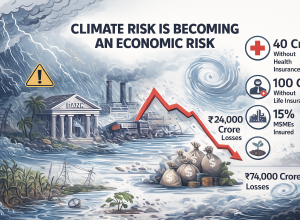On a typical day, over 100,000 flights crisscross the globe, leaving behind contrails and a staggering carbon footprint. As the world grapples with climate change, this dilemma in the area of aviation as become almost an existential challenge. The industry accounts for 2.5% of global CO₂ emissions, a figure projected to triple by 2050 without intervention. With electric planes still decades away from commercial viability for long-haul flights, and also as international travellers increasingly opt for carbon offsets, Sustainable Aviation Fuel (SAF) has emerged as the most realistic pathway to decarbonize air travel. Made from renewable sources like agricultural waste, algae, and even carbon captured from the air, SAF can reduce aviation’s carbon footprint by up to 80% compared to conventional jet fuel.
India, with its rapidly growing aviation market (projected to become the world’s third-largest by 2026) and vast agricultural resources, stands at a critical juncture. According to a Deloitte report highlighted in The Economic Times, India could produce 8-10 million tonnes of SAF annually by 2040, enough to meet 20% of its projected jet fuel demand. But will the country seize this opportunity, or remain grounded by policy inertia?
Every winter, northern India’s skies turn toxic as farmers burn an estimated 230 million tonnes of agricultural residue, primarily rice straw. This environmental catastrophe could instead become the foundation of India’s SAF industry. Praj Industries, a pioneer in biofuels, has already demonstrated that rice straw and sugarcane bagasse can be converted into drop-in aviation fuel through advanced biochemical processes.
The International Air Transport Association (IATA) sees India’s agricultural byproducts as a game-changer: “With proper collection infrastructure, India could supply enough feedstock not just for domestic needs but for export markets,” says Preeti Jain, IATA’s Assistant Director for India. The numbers support this optimism – every tonne of agricultural waste converted to SAF prevents 3 tonnes of CO₂ emissions compared to conventional jet fuel.
India’s 2.7 million tonnes of used cooking oil (UCO) generated annually presents another promising feedstock stream. Companies like Biofuels Junction are already aggregating UCO from restaurants and food processors for biodiesel production. Scaling this model for SAF could create a circular economy where Mumbai’s samosa oil eventually powers flights from Delhi to Dubai.
Despite its potential, India’s SAF industry remains in the taxiing phase. While the U.S. offers a $1.25/gallon tax credit for SAF producers and the EU mandates 2% blending from 2025, India lacks comparable incentives.
While the Bio-Aviation Turbine Fuel Policy (2021) marked a significant step in acknowledging Sustainable Aviation Fuel (SAF) as part of India’s energy transition, its impact has been limited due to a lack of enforceable regulations and financial mechanisms. The policy’s voluntary blending targets, rather than mandatory quotas, have failed to drive large-scale industry adoption. Unlike the European Union’s ReFuelEU mandate, which enforces a 2% SAF blending requirement from 2025, India’s approach relies on goodwill rather than binding commitments.
Compounding the issue is the absence of financial incentives for SAF producers. In contrast, the U.S. Inflation Reduction Act (IRA) provides a $1.25 per gallon tax credit, dramatically accelerating domestic SAF production. Without similar subsidies or tax breaks, Indian refiners and biofuel companies face prohibitive costs, making SAF three to five times more expensive than conventional jet fuel.
Additionally, India lacks standardized certification systems for alternative feedstocks like agricultural residue and used cooking oil. This regulatory gap creates uncertainty for investors and delays the scaling of new SAF production methods.
The consequences of this policy inertia are stark. An OpenPR market analysis projects that global SAF production will grow at a 40% compound annual growth rate (CAGR) through 2030, driven by aggressive mandates in the U.S. and Europe. Meanwhile, India—despite its vast agricultural waste resources and rapidly expanding aviation sector—risks falling behind in this critical energy transition. Without urgent policy reforms, the country may miss its chance to become a major SAF producer, instead becoming dependent on costly imports to meet future decarbonization targets.
The Indian Companies Betting on SAF
Praj Industries: The Biofuel Vanguard
The Pune-based company’s “Bio-Mobility” platform has already supplied test batches of SAF to Indian airlines. Their upcoming second-generation (2G) ethanol plants can be retrofitted for SAF production once economics improve.
Indian Oil: The Refinery Revolution
India’s largest oil company is converting part of its Panipat refinery to produce 87,000 tonnes/year of SAF from agricultural waste by 2025. As noted in The Economic Times, this pilot could catalyze industry-wide adoption.
Startups: The Disruptors
- Takachar (backed by Bill Gates) develops portable biomass converters for rural areas
- Bamboo Capital explores bamboo-based SAF in Northeast India
Three Possible Flight Paths
As India stands at the crossroads of sustainable aviation, its trajectory in the coming decades could follow one of three distinct scenarios, each with profound implications for its economy, environment, and global energy standing.
The most concerning outlook is The Laggard Scenario, where continued policy inertia leaves India dependent on imported SAF to meet international obligations. By 2040, without domestic production incentives, Indian airlines would be forced to purchase SAF at premium prices to comply with stringent EU blending mandates for Europe-bound flights. This import dependence would not only strain airline finances but also represent a missed opportunity to capitalize on India’s vast agricultural resources, keeping the country on the sidelines of the global green fuel revolution.
A more balanced middle ground emerges in The Middle Path Scenario, where measured policy interventions – perhaps a modest blending mandate of 1-2% combined with limited tax incentives – could unlock domestic SAF production of 3-5 million tonnes annually by 2040. While this would primarily serve domestic aviation needs, it would establish crucial infrastructure and know-how for future expansion. This scenario would see India meeting its own decarbonization goals while avoiding the worst aspects of import dependence, though without capturing the full economic potential of its feedstock advantages.
The most ambitious and transformative possibility is The Global Leader Scenario, where bold policy actions position India as the Saudi Arabia of sustainable aviation fuel. With aggressive blending mandates (5%+), robust production incentives, and strategic investments in feedstock supply chains, India could emerge as a major SAF exporter to Asia and Europe. This path wouldn’t just secure India’s energy independence in aviation – it would create an estimated 300,000 rural jobs in agricultural waste collection, slash farm fire pollution by 40%, and generate a staggering $15 billion in annual revenue according to Deloitte estimates. Such an outcome would transform India from an energy importer to a clean fuel powerhouse, while simultaneously addressing critical environmental and rural economic challenges.
The divergence between these scenarios underscores a critical truth: India’s future in sustainable aviation won’t be determined by technological constraints or resource limitations, but by the ambition and urgency of its policy framework in the coming years. The runway is clear – the question is whether India will taxi cautiously or accelerate toward leadership in the global SAF market.
The pieces are in place: abundant feedstock, proven technology, and hungry corporate players. What’s missing is the policy thrust – blending mandates, tax credits, and R&D funding – to get India’s SAF industry airborne.
As global aviation faces mounting pressure to decarbonize, India stands before a rare opportunity: to transform its agricultural waste into green gold, powering not just its own skies but those of the world. The question isn’t technical or economic – it’s political. Will India’s leaders have the vision to fuel this revolution?





